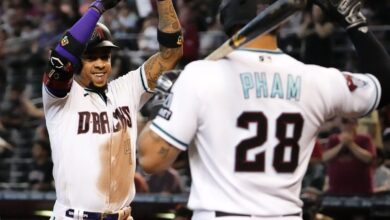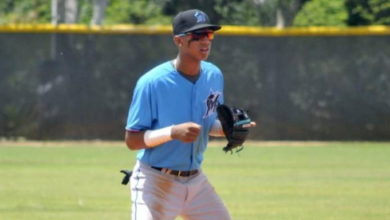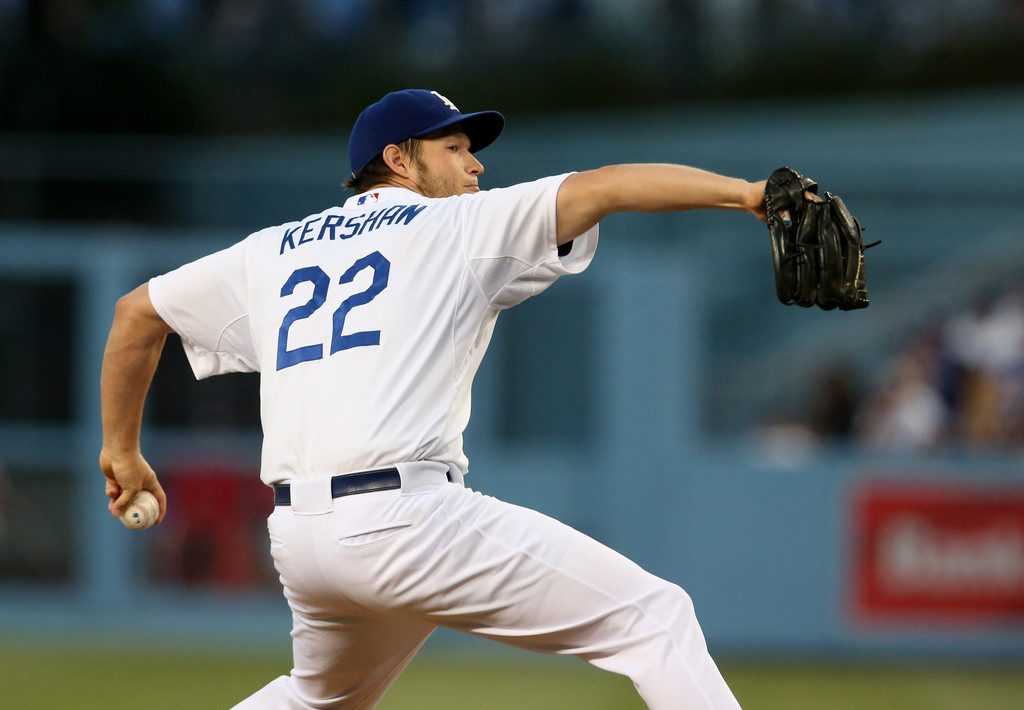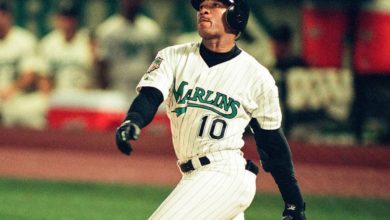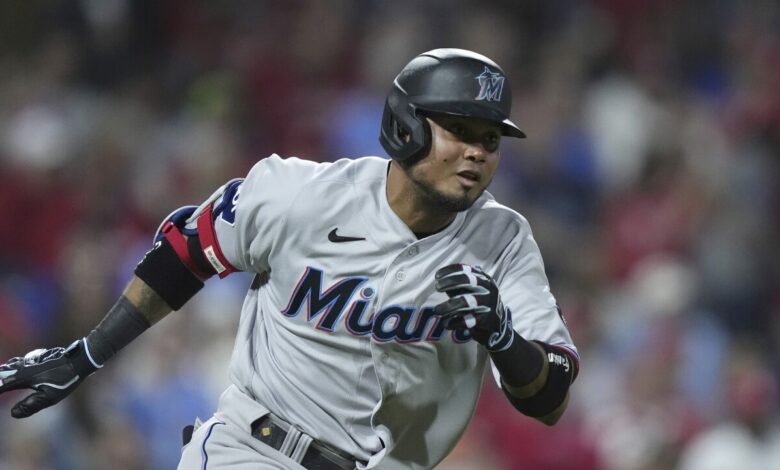
Is it possible for a major-leaguer to hit .400 in today’s baseball? Nobody who qualified for the batting title has done it since Ted Williams in 1941. If anybody can do it today, it’s Luis Arraez of the Miami Marlins. As I write this, he’s hitting .387/.442/.484 for the 2023 season. Although it’s only May, Arraez looks to be well on his way to a second consecutive batting championship, having won the American League title with the Minnesota Twins last season.
The deal goes down
Last January, Arraez became only the seventh batting champion in baseball history to be traded in the offseason after winning a batting title, when the Twins traded him to the Marlins for pitcher Pablo Lopez and two minor leaguers. The last time this happened, it was also the Twins dealing a batting champ. After winning his seventh and final batting title in 1978, the Twins traded Rod Carew to the California Angels. The most famous such trade came after the 1959 season, a blockbuster that saw the Detroit Tigers trade batting champ Harvey Kuenn to the Cleveland Indians for Rocky Colavito, the home run champ.
If Arraez wins the National League batting title as expected, he will become the third player in baseball history to win a batting title in both leagues and the first to do so in consecutive seasons. However, with full interleague play now in force, that accomplishment loses some of its luster, at least for me. After playing all over the infield and even seeing some action in left field for the Twins, Arraez seems to have settled in as the Marlins’ second baseman.
Why trade the batting champ?
Why trade a batting leader, especially a versatile 26-year-old who can’t become a free agent until 2026? Well, the Twins felt they had a need for more pitching depth while having sufficient infield depth in the minors. They may have also thought Arraez’s batting average wasn’t sustainable given his low hard contact rate, 28.1 percent for his career as I write this, well below the major-league average of 39 percent over that period. Finally, there may have been concern over the slump that saw Arraez’s average drop from .333 in July to .316.
At the time of the deal, Emma Baccellieri of Sports Illustrated found it “curious” from the Marlins’ standpoint. While acknowledging Lopez is not “an ace,” she felt the Marlins needed to add a power hitter, not another contact hitter, not even one who just won a batting title. I don’t agree. Sure, power hitters are nice to have, but small market teams generally can’t afford them.
The Marlins had an expensive one in Giancarlo Stanton. They traded him to the Yankees after he led the league with 59 home runs in 2017. The Marlins have gone on big spending sprees before, only to follow them up with fire sales. They probably want to proceed in a manner that’s more logical and less embarrassing. Like similarly situated teams such as the Rays, Pirates and Athletics, the Marlins want to build an offense around players with high on-base percentages. Arraez fits that bill at .381 for his career, .442 in 2023 thus far.
Under the radar
Not being a power hitter perhaps explains how Arraez manages to fly under the radar. Fans are obsessed with long homers, diving catches and players prancing around the field congratulating themselves for doing what they’re supposed to. But a well-placed single between shortstop and third base? Not so much.
What about Lopez? In nine starts for the Twins, he’s 2-2 with a 4.00 ERA and good peripheral numbers: a 1.074 WHIP, 3.84 FIP and a 4.71 strikeout-to-walk ratio. If he’s not an ace, at least it’s unlikely Twins fans will remember him like Cubs fans remember Ernie Broglio.
But I digress. Let’s get back to the original topic, whether Arraez can hit .400 for the season. There are three attributes I believe are necessary to accomplish this feat. The ideal candidate should bat left-handed, have adequate enough speed to leg out infield hits and have a high walk rate. The latter would indicate one doesn’t swing at bad pitches, and with fewer official at-bats, it would take fewer hits. Of these criteria, Arraez lacks only a high walk rate. For his career, he’s at 8.7 percent, just slightly above the 8.6 percent major-league average during that period.
Let’s get geeky
So how is Arraez hitting .387 without high rates of hard contact and walks? Let’s access our geeky sides and look at some tables. This first table shows the top 10 major-league batters with the lowest whiff rates in 2022, with other relevant statistics.
| Player | Whiff Rate | Exit Velocity | Hard Hit % | Line Drive % |
| Luis Arraez | 7.1 | 88.9 | 30.2 | 29.8 |
| Steven Kwan | 9.0 | 85.3 | 25.0 | 26.9 |
| Isiah Kiner-Falefa | 11.2 | 85.3 | 30.1 | 23.4 |
| Myles Straw | 12.6 | 86.7 | 26.5 | 26.2 |
| Michael Brantley | 12.7 | 89.7 | 45.8 | 30.7 |
| Tony Kemp | 13.1 | 82.2 | 14.9 | 22.9 |
| Jose Iglesias | 13.2 | 83.7 | 27.9 | 25.4 |
| Luis Guillorme | 13.3 | 84.9 | 24.9 | 27.3 |
| Wander Franco | 13.3 | 88.8 | 41.2 | 26.4 |
| Nico Hoerner | 14.2 | 87.1 | 33.8 | 23.5 |
| Arraez Rank | 1st | 2nd | 4th | 2nd |
Note that of this group, Arraez has the lowest whiff rate by far. However, he’s also second in exit velocity and line drive percentage. These percentages are highly unusual for a hitter with such a low whiff rate. His 88.2 career exit velocity is just about at major-league average for 2019-2023, the years of Arraez’s career. The line drive rate is higher than the major-league average of 24.5 percent over that same period. One would conclude these line drives are falling in front of outfielders due to Arraez’s low hard-hit rate. All of these figures point to a generational talent in the mold of Carew, Tony Gwynn and Wade Boggs.
Let’s get geekier
Let’s check out another table that shows percentage of batted balls pulled and hit up the middle and to the opposite field for this same group.
| Player | Pull % | Center % | Oppo % |
| Luis Arraez | 26.4 | 52.7 | 20.9 |
| Steven Kwan | 26.7 | 49.3 | 24.0 |
| Isiah Kiner-Falefa | 22.0 | 53.2 | 24.8 |
| Myles Straw | 15.0 | 57.7 | 27.3 |
| Michael Brantley | 28.1 | 54.4 | 17.5 |
| Tony Kemp | 36.5 | 46.8 | 16.7 |
| Jose Iglesias | 30.6 | 50.9 | 18.4 |
| Luis Guillorme | 20.9 | 60.1 | 19.0 |
| Wander Franco | 33.1 | 53.4 | 13.5 |
| Nico Hoerner | 23.2 | 52.3 | 24.4 |
| Arraez Rank | 6th | 6th | 5th |
Arraez ranks somewhere in the median in all of these percentages. This indicates Arraez might be more unpredictable, thus harder to defend, than your typical contact hitter. He can’t be profiled as a pull hitter or an opposite-field hitter. Furthermore, his spray charts bear this out. They show his hits are evenly distributed among left, center and right fields. Making contact, hitting the ball harder than most contact hitters, hitting the ball everywhere — that’s Arraez. That’s why he has a better chance to hit .400 in 2023 than anybody else.
“This guy can hit!!”
Or maybe no fancy analysis is needed at all. Let’s give the last word to former Marlin Juan Pierre, who texted the following to mlb.com after Arraez became the first Marlin to hit for the cycle in April: “I just remember my first thought watching him take batting practice I was like, ‘This guy can hit!!’ He was just spraying the ball around the whole field, not trying to hit home runs. Then I saw his cage work, and he does the same thing. Every day has a good routine, and there is a reason he’s a batting champ. He works!!”


